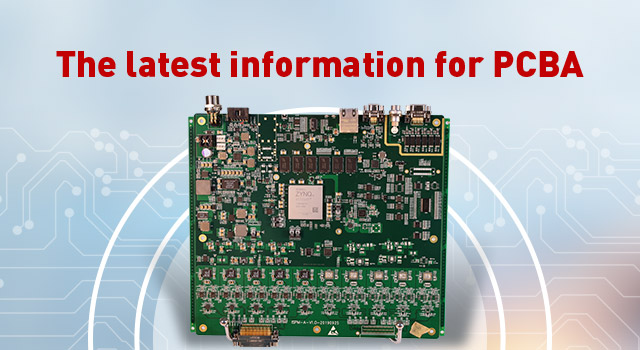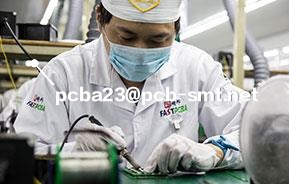
In SMT circuit board assembly process, two key crafts for PCB board repair
date:May 05,2019
Return listIn SMT circuit board assembly process, two key crafts for PCB board repair(1)
1.The two most critical crafts that help to successfully repairSMT are the two most overlooked issues:properly preheat the PCB before reflow; quickly cool the solder joint after reflowin SMT circuit board assembly process.
Since these two fundamental crafts are often overlooked by the repairtechnicians, in fact, sometimes the repairs are worse than before the repair. Although some "repair" defects can sometimes be found by later process inspectors, they are not always visible in most cases, but will be exposed immediately in future circuit testsin SMT circuit board assembly process.
It is true that long-term processing of PCBs at high temperatures (315-426 ° C) brings many potential problems. Thermal damage, such as soldering pad and lead warpage, substrate delamination, white spots or blistering, discoloration. Plate warping and burning usually cause the inspector to pay attention. However, precisely because it does not "burn out the board" does not mean that "the board is not damaged." The "invisible" damage of the high temperature to the PCB is even more serious than the problems listed above. For decades, numerous trials have repeatedly demonstrated that PCBs and their components can be “passed” after rework and test, with a higher decay rate than normal PCB boards. Such "invisible" problems such as internal warpage of the substrate and attenuation of its circuit components result from different expansion coefficients of different materials. Obviously, these problems are not self-exposedin SMT circuit board assembly process, and they have not been discovered even when starting circuit tests, but they are still lurking in PCB components.
Although it looks good after "repair", it is like a common saying: "The operation is successful, but the patient die unfortunately."
The cause of the huge thermal stress is that when the PCB componentsat normal temperature (21 ° C) suddenly contacts the soldering iron with a heat source of about 370 ° C, the soldering tool or the hot air head for local heating, the temperature difference of the circuit board and its components is about 349 ° C. Change, produce the phenomenon of "popcorn".
The phenomenon of "popcorn" refers to the phenomenon that moisture existing in an integrated circuit in SMT circuit board assembly processor SMD inside the device is rapidly heated during the repair process, causing the moisture to swell and micro or rupture. Therefore, the semiconductor industry andcircuit board manufacturing industry require production personnel to minimize the warm-up time and quickly rise to the reflow temperature before reflow. In fact, the PCB component reflow craftalready includes a preheating phase before reflow. Regardless of whether the PCB assembly plant uses wave soldering, infrared vapor phase or convection reflow soldering, each method is generally preheated or insulationtreated, and the temperature is generally 140-160 °C. Many problems in rework can be solved with a simple short-term preheating PCB before reflow soldering. This has been a success in the reflow craftfor several years. Therefore, the benefits of preheating the PCB componentsprior to reflow are manifold.
Since the preheating of the boardreduces the reflow temperature, wave soldering, IR/vapor phase welding, and convection reflow soldering can all be performed at about 260 °C.
3. The benefits of preheating are multifaceted and comprehensive
First, preheating or "insulation" components prior to initiating reflow helps to activate the flux, removing oxides and surface films from the surface of the metal to be welded, as well as volatiles from the flux itself. Accordingly, such cleaning of the activated flux just prior to reflow enhances the wetting effect in SMT circuit board assembly process. Preheating heats the entire componentsto a temperature below the melting point of the solder and reflow. This greatly reduces the risk of thermal shock to the substrate and its components. Otherwise rapid heating will increase the temperature gradient within the componentsand create a thermal shock. The large temperature gradients created within the componentswill create thermo-mechanical stresses that cause these low thermal expansion materials to embrittle, causing cracking and damage. SMT chip resistors and capacitors are particularly susceptible to thermal shock.
In addition, if the entire componentsarepreheated, the reflow temperature can be reduced and the reflow time can be shortened. If there is no preheating, the only way is to increase the reflow temperature further, or to extend the reflow time. Whichever method is not suitable, it should be avoided.
4. Reduced repairto make the board more reliable
As a reference for the soldering temperature, the soldering method is different, and the soldering temperature is different. For example, most of the wave soldering temperature is about 240-260 ° C, the vapor phase soldering temperature is about 215 ° C, and the reflow soldering temperature is about 230 ° C. Correctly speaking, the rework temperature is not higher than the reflow temperature. Although the temperature is close, it is never possible to reach the same temperature. This is because all rework processes only require heating of a local component, and reflow requires heating of the entire PCB assembly, whether it is wave soldering IR or vapor phase reflow solderingare the samein SMT circuit board assembly process.
Another factor that also limits the reflow temperature in rework is the requirement of the industry standard that the temperature of the components around the rework point must never exceed 170 °C. Therefore, the reflow temperature during rework should be compatible with the size of the PCB componentitself and the size of the component to be reflowed. Since it is essentially a partial rework of the PCB, the rework craftlimits the maintenance temperature of the PCB. The heating range for localized rework is higher than the temperature in the production craftto offset the heat adoptionof the entire board componentsin SMT circuit board assembly process.
In this sense, there is still no sufficient reason to say that the repair temperature of the entire board cannot be higher than the reflow temperature in the production craft, and thus close to the target temperature recommended by the semiconductor manufacturer.


